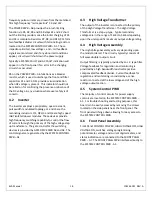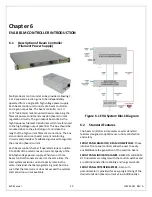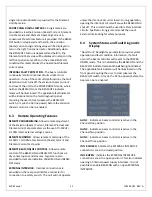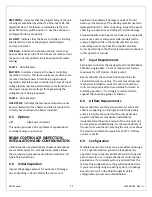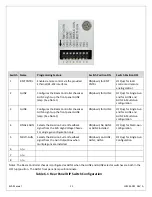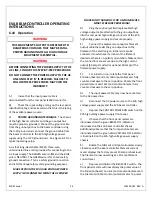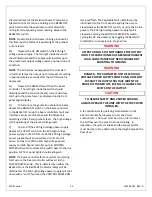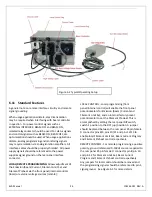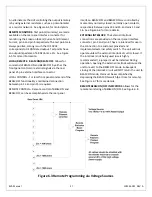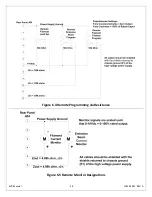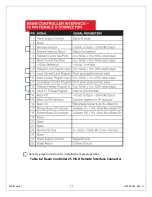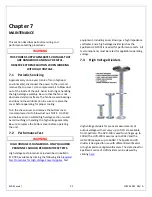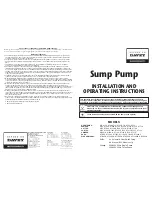
EVA
Manual
18
118144
‐
001
REV.
A
frequency
pulse
currents
are
drawn
from
the
metalized
film
high
frequency
“rail
capacitors”
C3
and
C12.
The
POWER
PWB
–
A6
provides
the
inrush
limiting
function
via
R1,
R2,
R3
and
R4.
Relays
K1
and
K2
short
out
the
limiting
resistors
once
the
initial
charging
of
C1
and
C2
is
complete.
Resistors
R7,
R8,
and
R10,
R11
form
two
feedback
divider
circuits
with
terminating
resistors
located
on
the
SYSTEM
CONTROL
PWB
–
A1.
These
impedance
limited,
low
voltage
+
and
–
rail
feedback
signals
are
monitored
and
if
any
abnormal
conditions
appear,
circuitry
will
shut
down
the
power
supply.
Typically
a
SYSTEM
FAULT
and
AC
FAULT
indication
will
appear
on
the
front
panel
if
an
error
in
the
charging
circuits
has
occurred.
R5
on
the
POWER
PWB
–
A6
functions
as
a
bleeder
resistor,
which
is
used
to
discharge
the
front
end
filter
capacitors
C1
and
C2.
DS1
provides
visual
indication
when
DC
voltage
is
present.
This
indicator
should
not
be
relied
on
for
confirming
the
presence
or
absence
of
the
DC
voltage
in
any
situation
where
user
safety
is
of
concern.
4.2
Inverter
The
inverter
employs
a
proprietary,
quasi
‐
resonant,
pulse
width
modulated
topology.
L1
and
L5
are
the
resonating
inductors.
Q1,
Q2
Q3
and
Q4
are
high
speed
IGBT
isolated
power
modules.
These
devices
provide
high
frequency
switching
capability
to
control
the
flow
of
current
through
the
primary
of
the
high
voltage
step
up
transformers.
The
gate
control
for
the
switching
devices
is
provided
by
GATE
DRIVE
PWB
A3
and
A4.
The
control
signals
are
generated
by
the
SYSTEM
CONTROL
PWB
–
A1.
4.3
High
Voltage
Transformer
The
output
of
the
Inverter
is
connected
to
the
primary
of
the
High
Voltage
Transformer.
The
High
Voltage
Transformer
is
a
step
‐
up
type.
Typical
secondary
voltages
are
in
the
range
of
1kVac
to
5kVac
depending
upon
the
units
specific
maximum
output
voltage
rating.
4.4
High
Voltage
Assembly
The
High
Voltage
Assembly
will
vary
depending
upon
the
model
ordered.
The
circuitry
typically
consists
of
full
wave
doubler
output
circuit.
Output
filtering
is
typically
provided
by
an
L
‐
C
type
filter.
Voltage
feedback
for
regulation
and
monitoring
is
provided
by
a
high
bandwidth
resistive/capacitive
compensated
feedback
divider.
Current
feedback
for
regulation
and
monitoring
is
provided
by
a
sense
resistor
connected
at
the
low
voltage
end
of
the
high
voltage
output
section.
4.5
System
Control
PWB
The
majority
of
control
circuits
for
power
supply
controls
are
located
on
the
SYSTEM
CONTROL
PWB
–
A1.
For
trouble
shooting
and
testing
purposes,
this
board
can
be
easily
accessed
by
removing
the
screws
located
on
the
side
panels
near
the
front
panel.
The
front
panel
will
hinge
down
allowing
for
easy
access
to
the
SYSTEM
CONTROL
PWB
4.6
Front
Panel
Assembly
Front
Panel
CONTROL
POWER,
HIGH
VOLTAGE
OFF,
HIGH
VOLTAGE
ON,
switches,
voltage
programming
potentiometer,
voltage
and
current
digital
meters,
and
status
indications
are
connected
to
the
FRONT
PANEL
PWB.
–
A7.
The
FRONT
PANEL
PWB
interfaces
directly
to
the
SYSTEM
CONTROL
PWB
‐
A1.















